The Remarkable Story and Saga of André Citroën and his
Breakthrough Traction-Avant
By Philippe H. Defechereux © 2017
Traction-Avant-Guarde!
Following our introductory piece about André Citroën and the first two years of his remarkable Traction-Avant (1934-1935), now is the perfect time to examine and wonder at the car’s thoroughly revolutionary character. In this article, we’ll list all the existing or innovative technologies Citroën and his team brilliantly and harmoniously brought together in order to create what can only be called “the first modern mass-produced automobile.”
Interwar Years and Mass Production
First, however, we must agree on a few key verified facts regarding the European car industry during our period of interest from 1919 to 1939. During the first of those two decades, few European manufacturers had fully endorsed or even tried “Fordism,” the genuine straightforward assembly line technique that could result in a carmaker producing over 35,000 cars per year at very low prices – a benchmark Henry Ford had reached by 1911!
As we saw in Part I, André Citroën was a leader in bringing across the Atlantic that Detroit-led car-making revolution. As early 1919, his first car, the “Type A” began production at the Quai de Javel plant, which had been from the start designed and built closely following Henry Ford’s assembly line principles. The Type A was “the first European car mass-produced in Europe.” By 1921, the Citroën plant was producing 100 cars a day; by 1923, 300 cars a day, or close to 50,000 cars a year. No other European carmaker came close.
This was because World War I caused such devastating losses of millions of young lives, high talent, creative energy and financial resources; it took the old continent a decade just to begin catching up.
André Citroën was an early and exemplary exception. By 1929, only his French competitors (Renault and Peugeot) and Italy’s Fiat (at Lingotto in 1923) had adopted of a degree of “Fordism” and were slowly increasing production rates. Naturally, so were the American subsidiaries of Ford (Dagenham and Cologne) and GM (Opel in Germany), but nothing like their parent companies in America.
Germany itself, most impoverished by its own war losses plus the crushing payback of the Versailles Treaty, experienced great political instability and had by far the lowest car ownership per population in Western Europe as the 1930s began and Hitler rose to power:
Cars on Road and per Inhabitant in Three European Countries in 1933 (*)
(*) Official government statistics found on Wikipedia.
As a result, during the interwar years, Germany’s many manufacturers had to concentrate on the fewer- but wealthier – customers who could afford cars. A number of carmakers experimented with smaller, cheaper models, but the vast majority of German workers could only afford to choose between motorcycles and public transportation.
Germany indeed needed a “People’s Car,” but it was fully delusional to believe that Hitler’s new Reich could afford to build both guns and beetles on a grand scale in the 1930s. The Volkswagen saga of 1934-1939 would sadly prove the point (see sidebar).
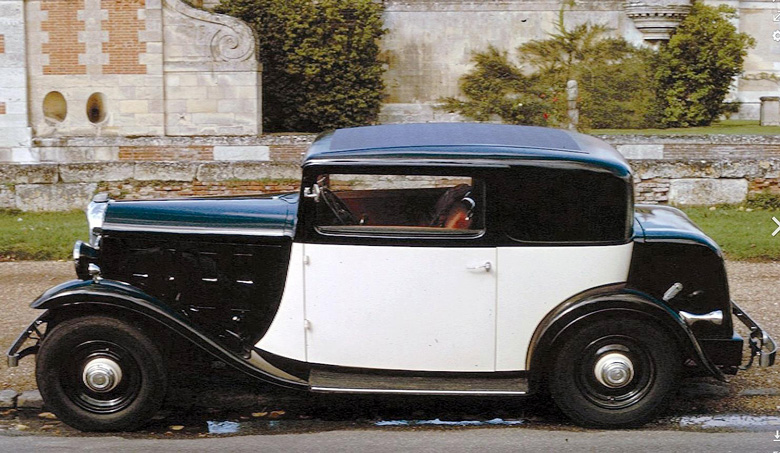
Citroën Rosalie Coupé 15CV, 1933 – The Traction-Avant’s predecessor. Between its launch in 1932 and 1935, this model sold an average of 23,800 units per year.
© Citroën/Wiki
The Citroën T-A: “The first modern mass-produced automobile.”
Following the above discussion for a basic, specific model (e.g. Fiat 509, Adler Trumpf, Citroën Traction-Avant), we will define the “mass-produced” label for the years 1919 to 1939 as a minimum of 20,000 units/year sustained over at least 5 years. “Series production” is normally used for runs from 5,000 to 20,000 units/year per model, while “Small series production” is traditionally used for less than 5,000 units/year for that era.
We show below the actual 1934 production numbers for the Citroën Traction-Avant (sub-models 7A, 7B, 7C, 7S and 11). Since production of this entirely new car in a brand new production facility started only in the month of March, 1934. What you are seeing in this chart are merely numbers for essentially three quarters of a year at startup rate; but they are real:
Citroën 7 (Traction-Avant) – Production Numbers for Start Year 1934
In the final years of peace between 1934 and 1939, Citroën produced roughly 105,000 Traction-Avants of various sub-types (7, 11, 15-6), or 21,000/year. Meanwhile, the Rosalie also remained in production until 1938.
Evolutionary and Revolutionary Features of the Traction Avant
Below, we list the many innovative features that the Traction-Avant brought together in a remarkable, harmonious whole. One of these innovations meant that the Traction Avant could be said to have featured independent four-wheel suspension. While doing our research, we found that there is often confusion about the design of the Traction Avant’s unique rear suspension. Some say it is ‘independent’ and others say not.
This author turned to Gijsbert-Paul Berk, who wrote the book André Lefebvre and the cars he created for Voison and Citroën. We asked: Did the Traction Avant have independent rear suspension?
Difficult question: The answer is no and yes. I will try to explain. It was a typical French (André Lefebvre) solution. The transverse torsion bars are connected to trailing arms which are mounted to a very light and rather flexible I beam axle to which the wheels are attached. So, in fact, from a pure theoretical point of view, it was not a real independent suspension. But just like the hollow front axle of the Bugatti 35, it had a certain elasticity. Don’t forget that many real independent suspension systems have torsion bar stabilizers that in fact counteract the independent movement of the suspension and wheels. Lefebvre was an aeronautic engineer and had designed aircraft at Voisin. So, he knew a lot about strong but flexible constructions.
To add further objectivity, if another manufacturer produced cars in small-series with a specific technology used in Citroën’s “Model 7” Traction-Avant before 1934, it will be noted.
• Welded Steel Unibody – Weight-saving (150 lb. per car) and torsional rigidity.
– Using licensed technology from the Budd Company (Philadelphia, PA).
• Front-Wheel Drive – Weight saving; interior space saving and lower center of gravity (no driveshaft needed).
– Several automakers produced FWD cars before 1934: Alvis FE 12-50 (1928, UK); Cord L29 (1929, US); Stoewer V5 (1930, Germany); DKW Front (1931, Germany); Adler Trumpf (1932), Germany). None of these can objectively be called “mass-produced” cars. All are actually “small series.”
• Cast-Aluminum Transaxle – Compactness, lightness and durability.
– A mass-production first.
• Overhead-Valve and “Wet Cylinders” Engine Design – More compact and better durability.
– Using licensed technology from Chrysler
• Engine Mounted on Dampers – Greatly reduces body vibrations; enhances comfort.
– Using licensed technology from Chrysler.
• Engine Positioned Inside Wheelbase – Improves weight distribution, road-handling and very spacious interior space.
– Mass production first (?)
• Hydraulic Brakes on all four wheels – Safety greatly enhanced.
– Replaced unreliable cable systems
– First used on passenger car by Duesenberg in 1921 (not patented)
– First practical use is of Malcolm Lockheed system of 1927
– First European production use in Lancia in 1932
• Front-Wheel Independent Suspension – Road-holding and steering comfort greatly enhanced.
– The Lancia Lambda pioneered Front-wheel independent suspension in 1922, but only 13,000 units were built over 9 years.
• Torsion Bar Suspension on all four wheels – Road-holding greatly enhanced.
– A mass-production first.
• Refined Aerodynamics and Low-Slung Overall Stance – Greatly improves roadability, speed and fuel efficiency (see details about latter two below).
– The Traction-Avant’s height was only 60 inches, or 18 inches lower than the average contemporary car; this was also less than one inch higher than the future VW Beetle.
– No reliable Cx for the car is known to the author, although a model of the car was wind-tunnel tested, as proven by a photograph.
• Aerodynamics and Overall Lightweight Design Yields speed with serious fuel economy – The lightweight design and aerodynamic body led to a remarkable fuel economy for this size of car, another objective set by André Citroën. With an overall length of 175.2”, a wheelbase of 115 inches but a curb weight of only 1,984 lbs, the first model produced, the 7A, was capable of reaching 100 kph (62 mph) with a fuel consumption of just 24 mpg.
So, André Citroën and his brilliant engineers/designers gifted prospective buyers with a dozen innovative technologies in critical design and performance areas in one single new mass-production car. As we showed above, a few of those technologies had been used in production cars before, but only singly (e.g. FWD), or in pairs (e.g. FWD and independent front suspension), and only in small series models, most built in the old-fashioned “body on frame” fashion, with leaf-spring rear axle suspension.
Most interesting is André Citroën’s dream, so clearly spelled out in the box bordered in red at the bottom of the introductory ad. Here is a translation, very telling:
“The completion of the new factories at Javel just brought both the power and perfection of Citroën production facilities to the highest degree of perfection: 400 engineer; 1,000 new machine-tools, bringing the total to 17,000; 90 hectares [220 acres] of workshops powered by a 60,00 HP plant; concentrate their efforts and their vast possibilities on manufacturing at the rate of 650 cars per day, the 8 – 10- 15CV [Rosalies] and the new 7 Traction-Avant. It is thanks to their industrial supremacy, that the Citroën factories can deliver at a surprisingly low price a new 7CV boasting an entirely new design conception, a car that supersedes in quality, comfort and elegance the most modern and best built automobiles.”
“Queen of the Road” – The Enlarged six-cylinder Citroën 15-6
The original “Model 7” Traction-Avant proved a very flexible platform to modify and expand upon. The 7A was improved three times in its first nine months of production (models 7B, 7C and 7S). In that sequence, engine displacement was systematically increased; for instance, the engine displacement of the 7S (“S” for Sport) was 1,911 cc (46 HP), compared to the 7As 1,303 cc (32 HP).
As an example, in 1935, a wider and longer Traction-Avant “Model 11” was launched, with its wheelbase increased by 9 cm; and length and width by 4 cm. The engine was the 1,911 cc unit of the 7S.
Then in 1938, André Lefèbvre and his team, never satisfied, went back to make the Traction-Avant an even more impressive car, by seamlessly adding two extra cylinders to the original powerplant, engine displacement jumped to 2,867 cc, and the bigger, six-pronged “rotisserie” now delivered 77 HP and a top speed of 135 kph.
This new model was named “15-6.” It took advantage of the “Model 11’s” enlarged body by further lengthening the wheelbase by 9 cm (to 122 inches) in order to accommodate the longer engine. At 2,260 lbs, the car was still very light for its size. André Citroën’s “diamond-in-the-rough” had now just become a big, perfectly polished, brilliant gemstone.
For despite its slight increases in size and weight, the 15-6 did not lose any of the basic design’s perfect roadability. In fact, it was so agile and easy to drive at speed, it often outperformed more powerful cars on curvy French roads. Thus, it was soon justifiably called “La Reine de la Route,” or “Queen of the Road,” in Citroën advertising.
That Traction-Avant would have an heroic and lugubrious career during WW II, then reach fame and glory in the post-war years.
Citroën Traction-Avant vs. Volkswagen Beetle
Now that we have established the 1934 Citroën 7 Traction-Avant to be indeed the “first modern mass-production automobile” ever to be made available to the public, wouldn’t it be interesting to compare it to the other famous “mass-production car” of the mid- 20th century, the VW Beetle?
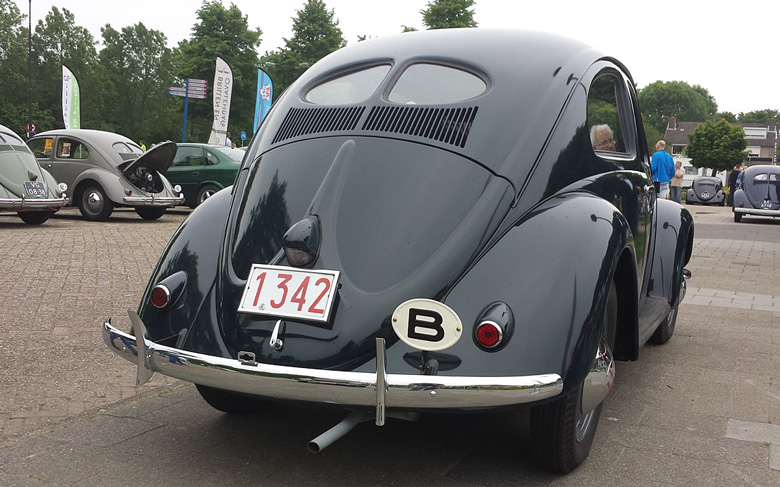
A very early production-for-public VW Beetle. This car was built in August 1948. It was restored by a VW and Porsche collector from Brussels, Belgium. Photo by Jacques Mertens.
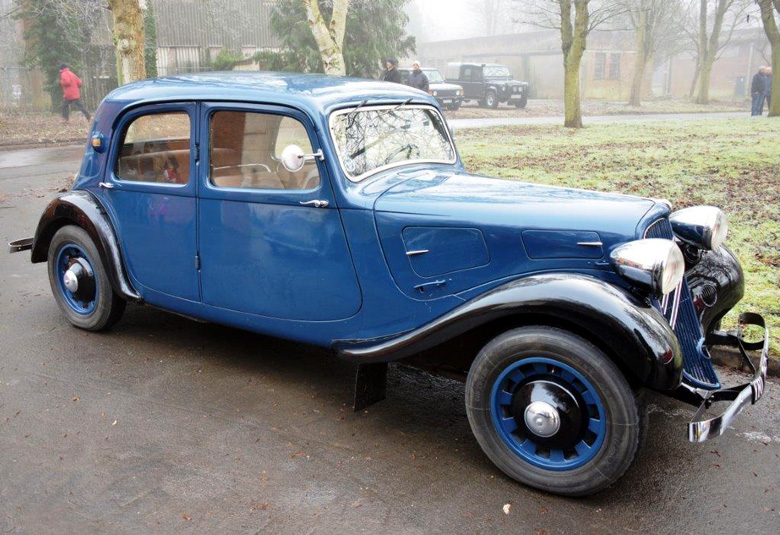
Citroën Model 7B Traction-Avant. Mass-produced in André Citroën’s ultra-modern new plant in Paris. Over 100,000 Traction-Avants would be built and sold openly between 1934 and 1939. Production resumed in 1945.
Of course it would. As the Traction-Avant was nearing the end of its long and successful life in the mid-1950’s, Hitler’s “People’s Car”, ordered in 1934 but never produced in quantity, had just been miraculously resuscitated on the eve of the 1950s. While the Traction-Avant, now two decades into its successful life, was about to cede the spotlight to its direct successor, the incomparable Citroën DS, the cheaper VW Beetle started to fill a need for a European public’s craving for affordable automobiles.
However, as you will clearly see in our exclusive comparative chart below, the Citroën Traction-Avant was a “People’s Car” in its own right, but for a somewhat wealthier population than that of 1930s Germany’s citizenry.
Among key comparative facts that will surprise most readers:
• While significantly larger, longer and roomier, the 1934 Traction-Avant had a weight essentially equal to that of the 1949 Beetle. Also, the low-slung Citroën was less than one inch higher on the road than the Volkswagen!
• The Traction-Avant had an engine with a larger displacement than the Beetle’s, and 40 percent more horsepower (35 HP vs. 25 HP). The Beetle was thriftier in gas consumption (30 mpg vs. 24 mpg). Their top speeds were equal (100 kph).
• Most significant of all, the Citroën’s basic layout – water-cooled front-engined FWD with wheels situated at the car’s four corners – became the world’s standard for small and mid-size passenger cars in the early 1970s and remains so today. It is no coincidence that the Volkswagen Golf, the car which in 1974 finally succeeded the fast-waning Beetle, followed André Citroën’s 1934 design concept to a “T.”
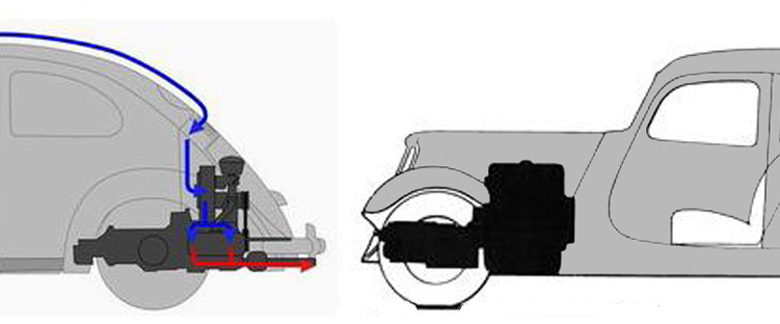
VW “outside the wheelbase” rear-engine layout of the VW Beetle compared to the “inside-the-wheelbase” front-engine layout of the Citroën is made plain by this visual comparison. The road-holding competence of the Ctiroën is by far superior, and became the norm since the 1970s.
Here is a good time to remember folk wisdom: “The sincerest form of flattery is imitation.” Even when it’s never recognized by the imitators.
It was only in late 1954, two decades after the Traction-Avant’s launch, and shortly before its leaving the spotlight to the Citroën DS, that the VW Beetle passed the 760,000 total units-sold mark. That would be the total number of Traction-Avants sold through 1957, when the production of this revolutionary automotive creation stopped.
Had André Citroën not died so early (at age 57 in 1935), the Citroën name, though still much alive today, would likely be still much more famous globally. In 1998, André Citroën was inducted in the Automobile Hall of Fame in Dearborn, Michigan. This honor was added to his four “Légion d’Honeur” awards he earned prior to 1934. Well-deserved American recognition.
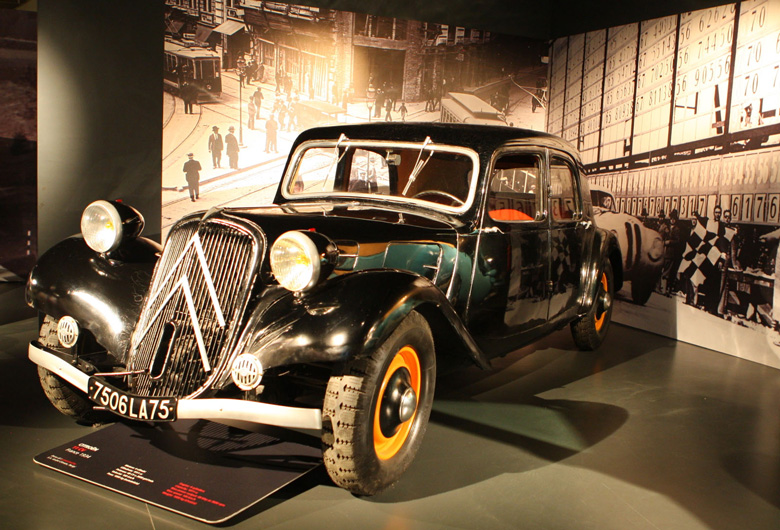
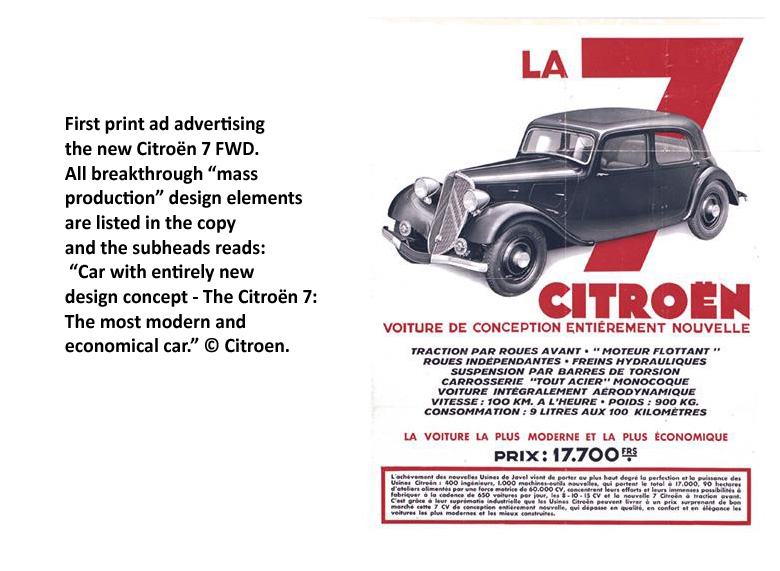
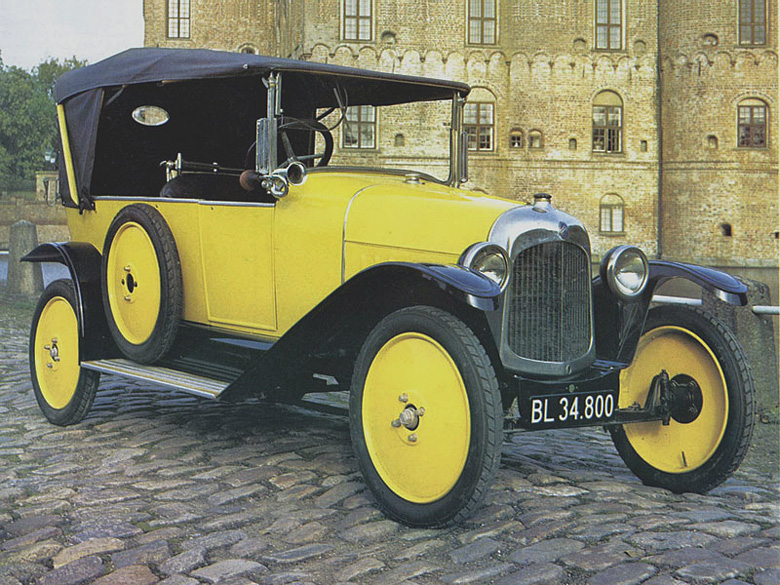
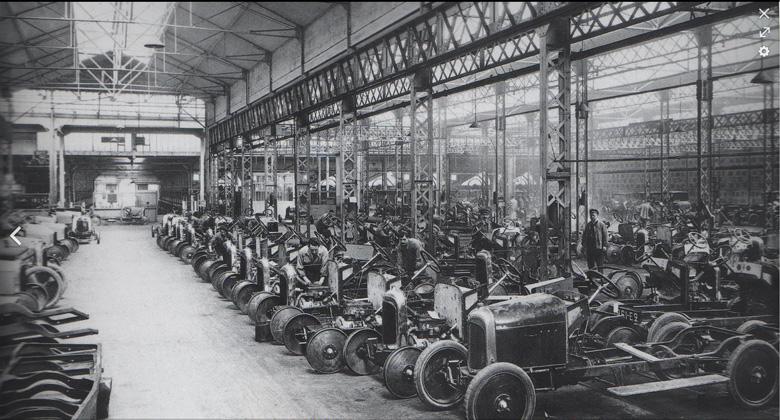



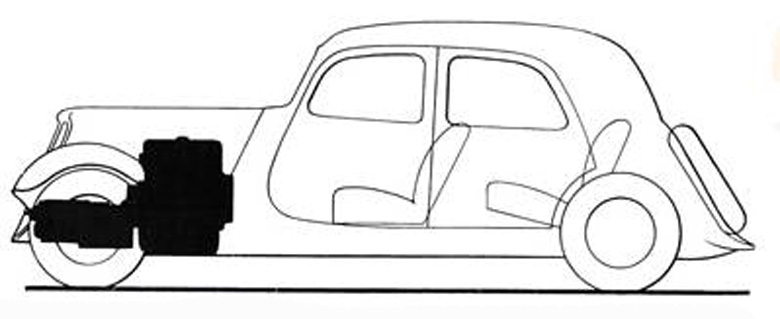
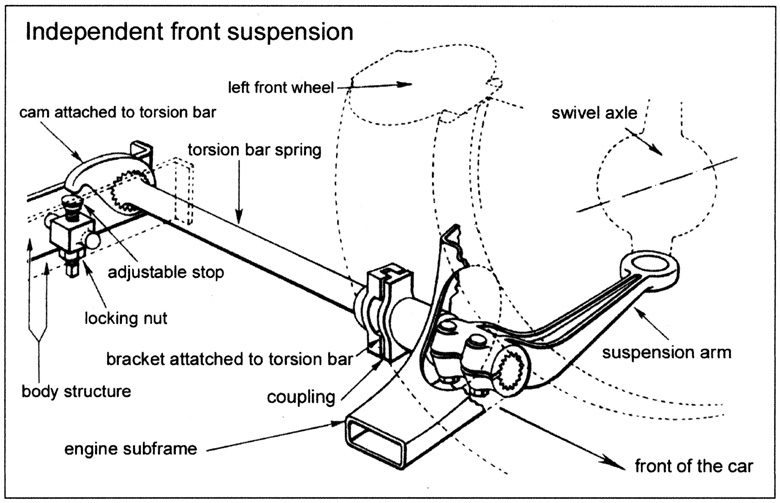
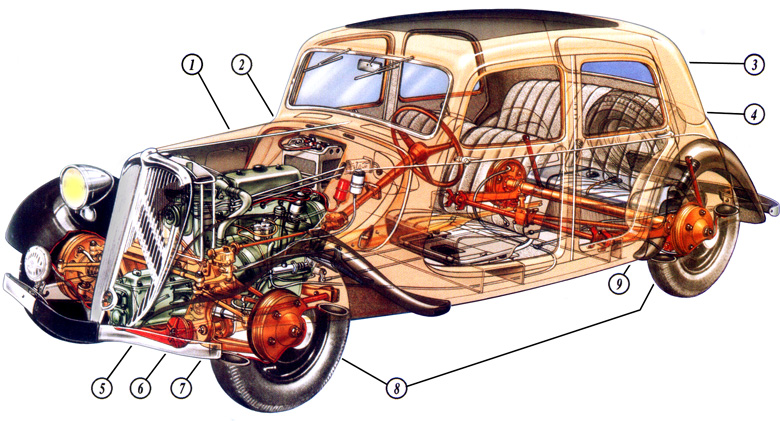
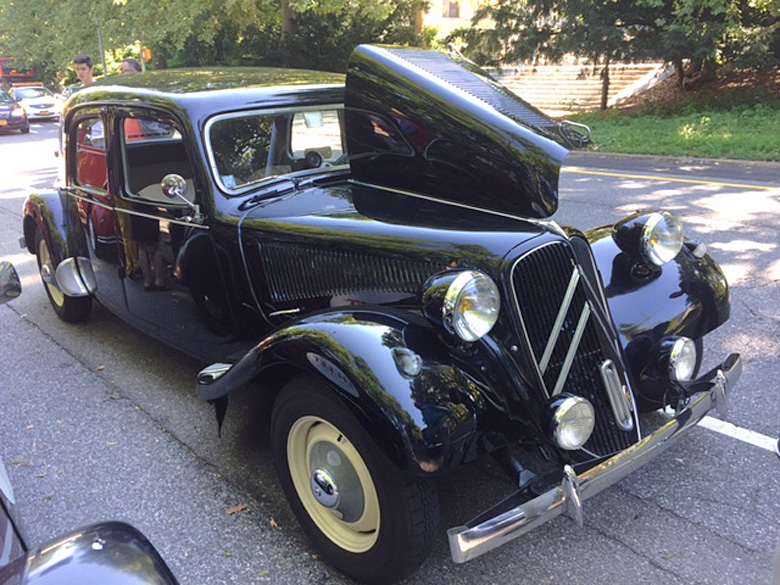

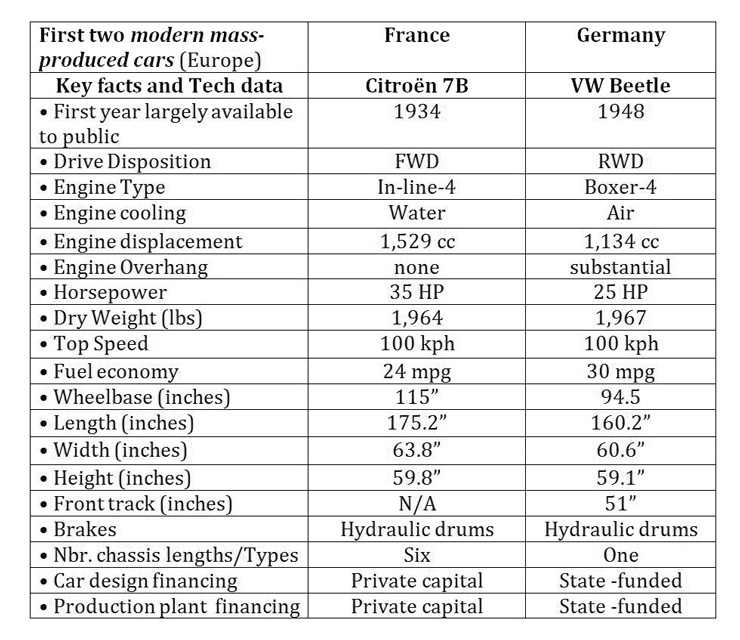
Fascinating, erudite, clearly written. Bravo.
Apart from the fact that both cars have their engine/gearbox units at the front, there is no similarity between the Citroen and VW Golf designs.
The Citroen engine/gearbox runs north/south and the VW runs east/west on the front axle line.
A fine article by Philippe Defechereux,most informative.As a long-term owner (35 years)
I would like to add a few nuggets : the Traction Avant was one of very few cars with centerpoint steering.The early cars had a steering box but rack&pinion took over in ’36.The steering is simply delightful,very direct (two turns lock to lock) and only a little heavy when parking.There is never any shimmy and the car tracks straight as an arrow.
Handling is excellent,the car simply following the front wheels under any circumstances with never more than mild understeer.With just 56 hp in a postwar car torque steer is not an issue.
A technical characteristic often overlooked is the fact that the valves form a 10° angle from the vertical with the head face.This provides for some “tumblehome” effect for the incoming charge which is good for combustion efficiency.My car,a 1947 11 Légère,uses about 10 liters per 100 km on a long run,about 27 mpg (imperial).
Top speed is about 120 km per hour but the perfect cruising speed is 90,the engine purring along nicely with plenty in hand.
Another feature is the completely flat floor of the car which allows one to perform a rather interesting party trick : on the motorway you can easily slide over to the passenger seat,steer with the left hand (holding the bottom section of the wheel) and left foot on the accelerator.You then wave at overtaking traffic that is gaping at a driverless car.Good clean fun.
If that blue Traction really is a 7b it is a bit of a mongrel.It should have a moleskine panel in the roof,a different hood (vent doors should open in the same direction) and the wheels are 1938-1946 Michelin Pilote items.
As for comparisons with the beetle,at the risk of kicking a few shins,that is the car that proves that 22 million people can be wrong. Greets,Michel Van Peel
Bravo Philippe, jolie présentation, belles photos, on voit que tu es un pro !!
Bisous d’une Gazelle française !
Interesting and fun.
Lovely story, but the photo claiming to be of a 15-6 is in fact a 4-cylinder car, an 11B – in the longer, wider body shared with the 15-6. Many detail differences between the 4 and 6 cylinder versions. I once owned one exactly the same as the car in the photo, just unrestored.
Thanks for the help…yes, the cars are a bit hard to differentiate, and the photographer’s don’t always get it right!
Editor